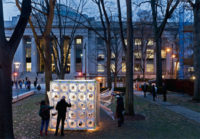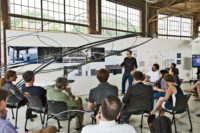Urban-Think Tank
Urban-Think Tank stacks multiple structures to meet the myriad needs of the barrio.

The architects propose modular metal stairs for the barrios based on one realized for the Altamira neighborhood in 2003.
Photo © Ricardo Parra

Currently Urban-Think Tank is working on two vertical gyms for the barrios. One, proposed for Los Teques, includes a swimming pool.

Another gym, in construction in Baruta, features a colorful polycarbonate skin.

“Growing House” (2004), a residential framework of platforms and columns, can be filled in by occupants.

Currently Urban-Think Tank is working on two vertical gyms for the barrios. One, proposed for Los Teques, includes a swimming pool.

Another gym, in construction in Baruta, features a colorful polycarbonate skin.


Urban-Think Tank is designing five stations akin to its proposal for Manguitos station in the San Augustin barrio.

A Columbia University tabloid chronicles the work of U-TT’s design studio there last spring.





Post a comment to this article
Report Abusive Comment